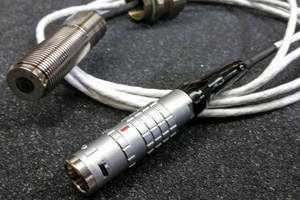- info@motionsensors.com
- Monday - Thursday: 8AM to 5PM EST
- 252-331-2080
RF (Eddy Current) Speed Sensors
RF speed sensors offer low speed response, no drag, large air gaps and sensing characteristics which enable this type of speed sensor to sense non-ferrous metals like aluminum or nonmagnetic stainless steel in addition to ferrous metal. Unlike their VR counterparts, an RF speed sensor is not a passive device and requires coupling with a signal conditioner/preamplifier. These devices produce a digital square wave output versus the analog sine wave of the VR speed sensor.
RF Speed Sensor Types
- RF Sensors – Standard – Standard versions have open fronts and are epoxy encapsulated. Also available are models with closed fronts as well as hermetically sealed versions for applications that require protection from moisture and other fluids.
- RF Sensors – High Temp – Built to operate in temperature ranges beyond that of our standard RF sensors, up to 750°F.
- Active Speed Sensors – RF Models – These models integrate a preamplifier within the sensor housing and offer excellent noise immunity and greater transmission capability.
- Intrinsically Safe RF Speed Sensors – Certified intrinsically safe to CSA (with NRTL/C), ATEX (2014/34/EU), and IECEx (IEC 60079-0:2011 and IEC 60079-11:2011).
- Explosion Proof RF Speed Sensors – Ex d certified to ATEX and IECEx and comply with the essential health and safety requirements relating to the design and construction of equipment and protective systems intended for use in potentially explosive atmospheres.
Custom RF Speed Sensors
In addition to our standard models, RF speed sensors are available in custom lengths, diameters, configurations, and mounting threads. Custom operating specifications (output options, etc.) are available, as well as options such as pigtail leads or NPT threading. See additional sensor customization options.
Principles of Operation – RF (Eddy Current) Speed Sensors
Advantages of Motion Sensors RF sensors are: near zero speed response, no magnetic drag, large air gaps, and the ability to sense non-ferrous metals like aluminum and nonmagnetic stainless steel, as well as ferrous metals. RF sensors use a modulated carrier signal to sense rotating metals. Unlike their Variable Reluctance (VR) counterparts, RF sensors require an internal or external preamplifier/signal conditioner to operate. When a target is sensed, eddy currents are formed which decrease the signal amplitude. The preamplifier/signal conditioner demodulates the signal, detects the voltage drop-offs, and produces a square pulse wave (digital) output with a frequency directly proportional to the number of turbine blades, gear teeth, etc. that have been sensed.

